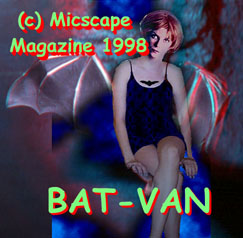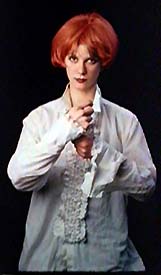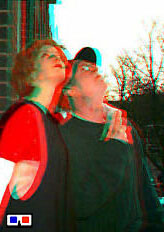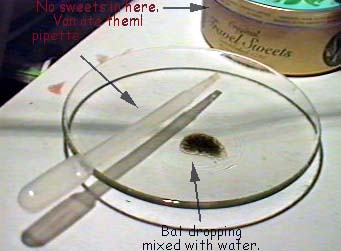

| Encounter in Scotland (Page 5) |
 We are back in London and 4 weeks have past since our trip to Edinburgh.
I asked Larry if I could write half of this page because, in seeing how
he wrote about our trip to Edinburgh in the last few pages, and how he
included so much about me and my problems, I was concerned you might think
we were not helping anyone to learn about bats.
We are back in London and 4 weeks have past since our trip to Edinburgh.
I asked Larry if I could write half of this page because, in seeing how
he wrote about our trip to Edinburgh in the last few pages, and how he
included so much about me and my problems, I was concerned you might think
we were not helping anyone to learn about bats.
In fact, you might also think our experiences have nothing to do with Microscopy or the study of the microscopical world. Well, I'll prove you wrong in a moment when Larry and I explain how to use a microscope to study them. I can see what Larry was trying to do... but then I know him very well. Larry is trying to show that study of our world can only take place through people driven to be curious about the nature of things. Often, like me, many people suffer experiences that hurt so much they need to look deeper and harder at the world they live in... either to find something of value to hang onto, or to make sense of their suffering. Thank God for such pain and dissatisfaction because, without it, we would probably just coast by not really caring about life outside of humankind nor learning about our world. Bats
are extraordinary creatures. They are mammals like us. They live in the
dark and employ a completely different way of 'seeing' things to survive.
I can really associate with this. People like me who get clinically depressed are everywhere... in your office, in your homes, out there on the streets. Many of them have learned to adopt extraordinary processes and will power to carry on during their bad periods until the 'blues' lift. I was very ill when we were in Scotland... an impossible experience to explain! One's mind shuts down and you become lost inside a strange cotton-wool world where everything seems remote, where you can see everything happening around you but you are no longer part of it. Thought processes wind down to such an extent, it is difficult to actually consider yourself as being alive and human. You can hardly think much without being prompted. It's a world where every thought and every movement is a Herculean task. A dark world indeed! And the worst thing of all is that when you are there frozen inside a solid-glass cage of isolation, you just can't remember what it was like to be well. The bats, I remember though, especially the night by the church when I heard their 'invisible' calls for the first time. I still believe that moment became my life-line back to the world of normality - not immediately, but something was stirred and encouraged that strange evening. I'm still not back to my normal self but I can function again now. Larry suggested I give up my job and in awhile find something less stressful. To make sure I use my recuperation days wisely, I am... guess what... yes: I'm studying bats! I found some great books and although I find reading very difficult at the moment, I am learning about British bats. Here's me below, looking a little more cheerful, wading through a lot of volumes to find snippets here and there. |
 She's doing well and improving daily since she gave up teaching... which I asked her to do because it was the stress at work causing her problems. Hell, we'll get by on my money if we live simple like, and I prefer to have my honey safe and well and live on bread and water meself than see her suffer. Edinburgh taught us something about friends as well as bats... and all ours are great! Anyway, since we got back, Van has been doing some microscopy on the bat-dropping samples I collected from my car and some extra ones found locally. If yer know what to do with these dried up pellets, yer can get to see what yer local bats are living on at night. I'll just mention here, before I show you how to study bats thru their droppings, that Bats are highly protected in Britain by the 1981 Wildlife and Countryside Act. You mustn't go disturbing 'em or anything. If one gets in yer house in a non-living area, you must not touch it! if one strays into yer living area (highly unlikely), you can gently remove it but must not injure it in any way. To study them at close quarters, you need a licence from English Nature. That said... you can always look for their tell-tale droppings around the base of likely buildings. You can learn much from studying these under the old scope.
"Hey, honey, yer not gonna see much that way, but while yer have a bat dropping in yer hand, could you show the folks reading our pages what it looks like for me."
|

Here are a few facts I have discovered so far:-
|
|
| Right, I'm back. What I've done is mix up one of the pellets with some distilled water. You can use ordinary water if you like but distilled water is cleaner and purer! | |
 |
|
|
|
|
     |